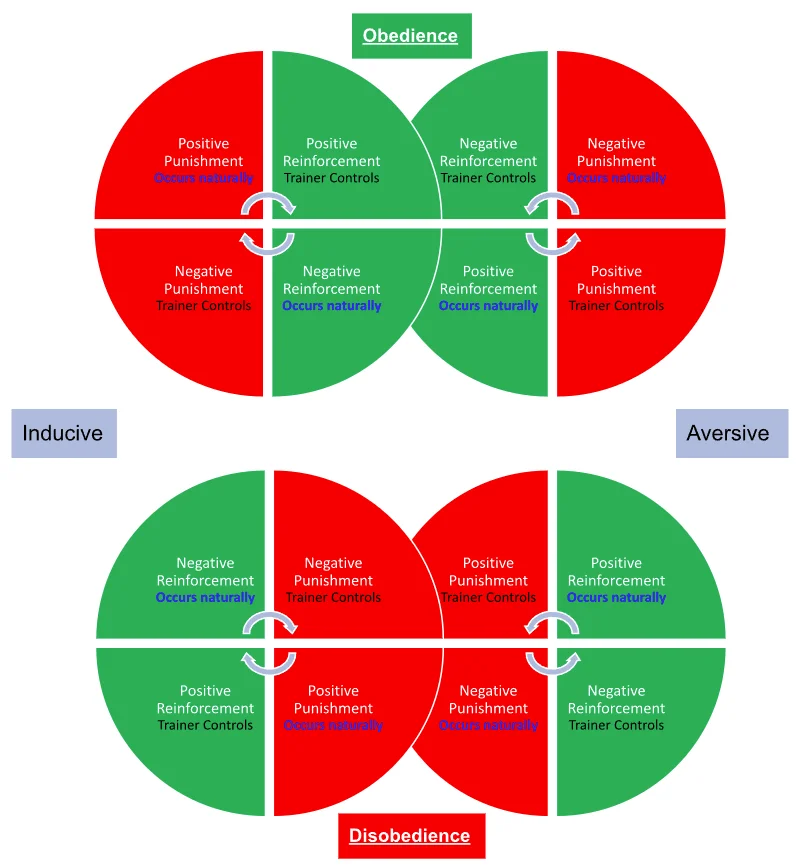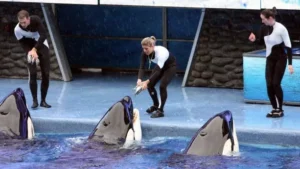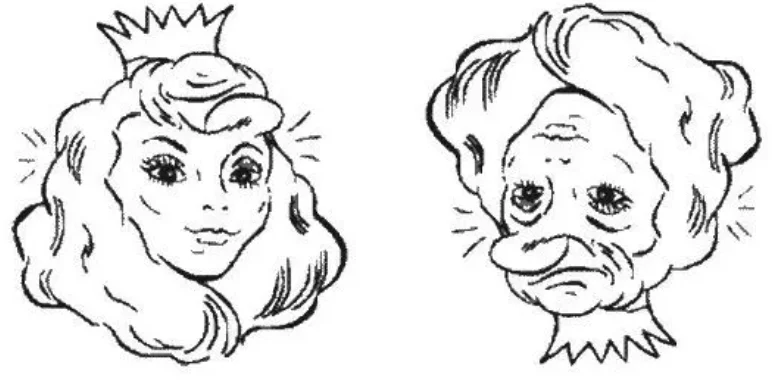Http://OperantConditioning.Info

Objectives:
- Define Operant Conditioning
- Define the Traditional Quadrants
- Understand the Silent Sides of Operant Conditioning
- Understand why Operant Conditioning Quadrants are flawed as a gauge for defining welfare.
Operant Conditioning occurs when dogs learn through the consequences of their voluntary behavior.
Keep things simple by using these definitions for the purpose of training:
Do one of these AFTER a behavior:
| Positive | add something |
| Negative | remove something |
For one of these reasons:
| Reinforcement | to encourage that behavior |
| Punishment | to discourage that behavior |
Combine these simple definitions to make simple and accurate definitions for the phases:
| Positive reinforcement | Add something to encourage behavior |
| Positive punishment | add something to discourage behavior |
| Negative reinforcement | Remove something to encourage behavior |
| Negative punishment | remove something to discourage behavior |
Understand the Silent Sides of Operant Conditioning
Operant conditioning only explains the learning process through the perspective of the trainer or observer. Rarely is the perspective of the dog or learner addressed.
To better understand why or why not operant conditioning succeeds or fails, do not focus on what technique or tool is used or even the physical sensations that are added or removed. Instead, focus on the emotional experiences that are added and removed.
Different tools and techniques delivered in the same way to different dogs or the same dogs during different circumstances may produce different sensations depending on the current emotional states and the biological differences of each dog.
Additionally, those sensations may produce different emotional experiences for different dogs in different circumstances if the dogs have different pre-existing associations with those sensations (classical conditioning) or have experienced desensitization/sensitization.
Electric Stimulation
| Antecedent/ History | technique | Sensation | Emotion when added | Emotion when removed |
| A dog is highly aroused while chasing a rabbit or lunging on a leash at another dog. | mid-level shock | mildly uncomfortable | indifferent | indifferent |
| A dog has previous associations with gaining access to food or play after an electric stimulation. | mid-level shock | uncomfortable | excitement | anticipation |
| An unaroused dog with no previous exposure to shock is curiously investigating the smells around the property border. | mid-level shock | uncomfortable | fear | relief |
Store Bought Dog Treat
| Antecedent/ History | technique | Sensation | Emotion when added | Emotion when removed |
| A satiated dog that is fed home cooked meals. | liver treat | liver flavor/smell | mildly satisfied, indifferent, or repulsed. | Indifferent |
| A dog whose trainer uses calorie deprivation to create motivation. | liver treat | liver flavor/smell | satisfaction / excitement | hunger / frustration |
| A dog with previous bad experiences eating novel food. | liver treat | liver flavor/smell | confusion / fear | relief |
When training is inducive and effective, the trainer controls something the dog likes to shape behavior. Then, operant conditioning cycles in an exact order:
The trainer adds and removes something that directly influences good emotions.
As a result, this naturally influences bad emotions. The trainer cannot prevent this from happening if the training is reasonably effective.
Example using food:
| During Obedience | Satisfaction (via food) is added by the trainer. |
| As a result, frustration is removed naturally. | |
| During Disobedience | Satisfaction (via food) is removed by the trainer. |
| As a result, frustration is added naturally. |
Freedom and food look like positive reinforcers, but when they are contingent on the cessation of artificially imposed deprivations, their effectiveness is a product of negative reinforcement; they become instruments of coercion (41).
Sidman, M. (1989). Coercion and its Fallout. Boston: Authors Cooperative
When training is aversive and effective, the trainer controls something the dog dislikes to shape behavior. Then, operant conditioning cycles in the opposite direction. It can be represented by reversing the direction of the inducive training chart.
The trainer adds and removes something that directly influences bad emotions.
As a result, this naturally influences good emotions. The trainer cannot prevent this from happening if the training is reasonably effective.
Example using a training collar:
| During Obedience | Discomfort (via the training collar) is removed by the trainer. |
| As a result, Comfort is added naturally. | |
| During Disobedience | Discomfort (via training collar) is added by the trainer. |
| As a result, comfort is removed naturally. |
… it is impossible to construct a behavioral system free of aversive control. The forms of behavioral control we call “positive” and “negative” are inextricably linked. Thus, decisions about “good” and “bad” methods of control must be decided quite apart from the questions of whether the methods meet the technical specification of “positive reinforcement” or "aversive” control. We need to seek a higher standard, one that emphasizes outcomes more than procedures. Our chief concern should not be whether the contingencies involve the processes of positive reinforcement, negative reinforcement, or punishment. Instead, we should emphasize the ability of the contingencies to foster behavior in the long-term interest of the individual. Of course, this is all we can ask of any behavioral intervention, regardless of its classification. (Perone, 2003, p. 13, italics added)
B.F Skinner - Freedom is the absence of aversive control
Israel Goldiamond - Freedom is genuine choices
When training is inducive and aversive, the trainer controls things the dog likes and dislikes to shape behavior. Then, two inversely related operant conditioning cycles overlap, allowing the trainer to have full control over all four phases at all times.
Example using food and training collar at the same time:
| During Obedience | Satisfaction is added and discomfort is removed by the trainer. |
| As a result, frustration is removed and comfort is added naturally. | |
| During Disobedience | Satisfaction is removed and discomfort is added by the trainer. |
| As a result, frustration is added and comfort is removed naturally. |
What are the benefits of combining?
- More trainer control of “Go and Stop” (do and don't, hot and cold) at the same time.
- Two “good” emotions and two “bad” emotions instead of one of each.
- If one does not rely on just one emotional response at a time, the intensity of each response may be lowered for similar results.
- Less hunger
- Less discomfort
- Less frustration
- Enjoyable learning levels
- more room for error
- errors in timing
- errors in the reinforcement schedule
- satiation
- training equipment
- errors in magnitude of reinforcement or punishment
- more versatility (if can't do one or the other)
- Trainer-controlled “bad emotions” are generally faster, more easily removed, and more effective for stopping behavior.
- Trainer-controlled “good emotions” are generally faster, more easily added, and effective for encouraging new behavior.
Now, it is possible to rethink perceptions about tools and techniques used in animal training:
Using food in training. Is it positive or negative? Is it used as a tool to reinforce or punish?
Answer: It can be all of the above.
Is using food abusive?
Hunger used is excess or in a way where the animal does not understand how to avoid and relieve hunger/frustration may cause mental and physical side effects. This will be considered inhumane by a reasonable person.
To create new successful behaviors, reasonable people agree food training can enhance the long-term quality of life for an animal and its owner.
Using any training collar (head halter/slip/prong/ecollar/no-pull harness). Is it positive or negative? Is it used as a tool to reinforce or punish?
Answer: It can be all of the above.
Are training collars abusive?
Discomfort used in excess or in a way that the animal does not understand how to avoid and relieve discomfort may cause mental and physical side effects. A reasonable person would consider this inhumane.
Reasonable people agree that using a training collar can enhance the long-term quality of life for an animal and its owner by creating new successful behaviors.
Baron A and Galizio M (2005). Positive and negative reinforcement: Should the distinction be preserved? The Behavior Analyst, 28: 85-98.
“In summary, if we are to continue to talk about two kinds of reinforcement, we advise caution in the ways the terms are used. The continued role played by the terms positive and negative reinforcement in behavior-analytic discussions suggests that the distinction is serving a useful communicative function. The terms make it plain that when we are talking about reinforcers we are referring to environmental events rather than cognitive or physiological happenings. They provide a shorthand way of pointing to the reinforcers that have traditionally been used for the experimental study of different problem areas: positive reinforcement in the case of schedules, choice, and stimulus control (food is presented), and negative reinforcement for escape and avoidance (shock is terminated). Moreover, the distinction is so well embedded within discussions of operant behavior that one cannot navigate the literature without being familiar with it. These considerations may be good enough reason to continue to teach the distinction to our students. Nevertheless, it is apparent that the terms positive and negative come with considerable conceptual baggage. By remembering the ambiguities inherent within the distinction, we are less likely to use it to justify ethical or practical decisions. At the least, we should recognize that the question of functional differences between positive and negative reinforcement remains controversial.”
Michael, J. (1975). Positive and negative reinforcement: A distinction that is no longer necessary; or a better way to talk about things. Behaviorism, 3:33-44
“Hangry” studies in humans:
In humans, hunger has been scientifically connected to being sad, irritated, and angry.
https://journals.plos.org/plosone/article?id=10.1371/journal.pone.0269629
In animals:
https://www.sciencedirect.com/science/article/pii/S0003347221001378?via%3Dihub
https://academic.oup.com/endo/article/154/11/4328/2423148?login=false
The SeaWorld incident. Orcas are trained with positive reinforcement. But, they are also trained silently with motivational levels of positive punishment, negative punishment, and negative reinforcement with side effects of aggression.
The frustration related to hunger is thought by many experts to be the cause of aggression toward the trainers.
SeaWorld likes to talk about the relationships between the trainer and the animal. They tend to de-emphasize the role that food plays in that relationship. I know that that’s kind of a sad undercurrent…. It’s true that there exists some relationship between trainer and animal, but the question is what type of relationship. One based on love? Or hunger?
- Jeffrey Ventre, Sea World Trainer https://www.earthisland.org/journal/index.php/articles/entry/in_conversation_with_jeffrey_ventre/
Is it positive reinforcement or negative reinforcement? It depends on which way you want to spin it.
Situations to Consider
| Dog's Environment | Training Technique | Result |
|---|---|---|
| Aversive | Inducive | Deprivation |
| Inducive | Aversive | LIMA |
| Aversive | Aversive | Inarguably Inhumane |
| Inducive | Inducive | No reliability possible |
Additional Information on Deceptive Practices in the Dog Training Industry:
Fraud in the Force-Free/Purely Positive Dog Training Marketing Tactic:

Karen Overall Violates the AVMA Code of Conduct and Violates Guidelines set by the Fair Trade Commission:

What REALLY is LIMA in Dog Training?










Responses